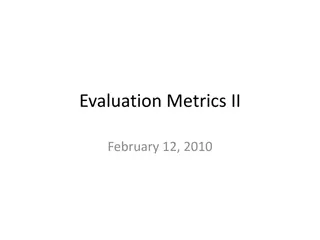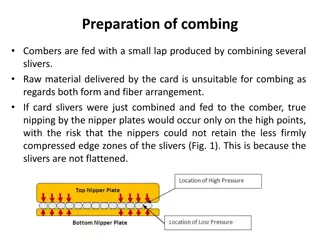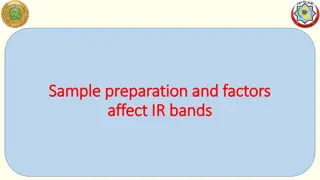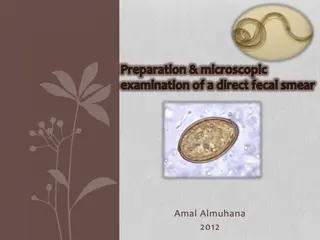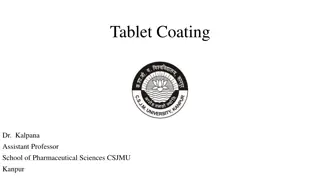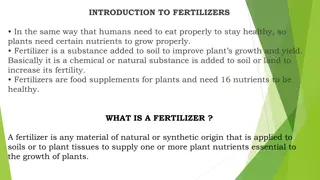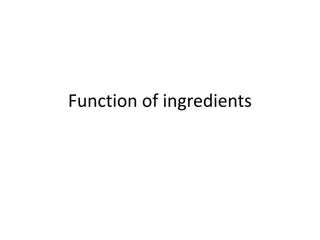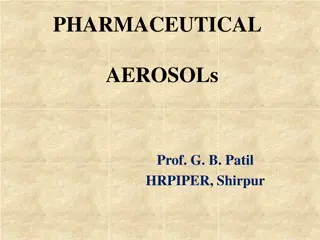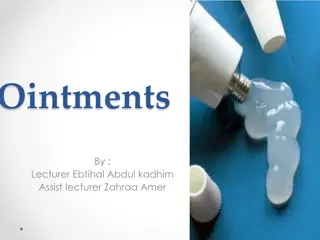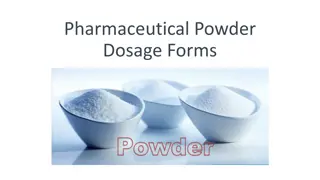Understanding Suppositories: Types, Advantages, and Preparation
Suppositories are solid dosage forms used for localized or systemic effects by inserting into body orifices. They come in different bases such as fatty bases and water-soluble bases, and are prepared through fusion or compression methods. They offer advantages like targeted action, overcoming digestive issues, and suitability for patients unable to swallow medications.
Download Presentation

Please find below an Image/Link to download the presentation.
The content on the website is provided AS IS for your information and personal use only. It may not be sold, licensed, or shared on other websites without obtaining consent from the author. Download presentation by click this link. If you encounter any issues during the download, it is possible that the publisher has removed the file from their server.
E N D
Presentation Transcript
Suppositories Suppositories By Lect. EbtihalAbdul Kadhim Assist. Lect. ZahraaAmer
SUPPOSITORIES SUPPOSITORIES Are solid dosage forms intended for insertion into body orifices (such as vaginal or rectal cavity) where they melt, soften or dissolve and exert localized or systemic effects. The shape and size of a suppository must be such that it is capable of being easily inserted into the intended body orifice without causing undue distention, and once inserted, it must be retained for appropriate period .
Advantages of Suppository Advantages of Suppository Used to exert local action on the rectum and the vagina, such as in case of hemorrhoids, constipation and infections. Used for drugs destroyed or inactivated by the pH or enzymatic activity of the stomach or intestines. Used for drugs irritating to the stomach. Used for patients who may be unable or unwilling to swallow medication ( as in infants) Used as an effective route in treatment of patients with vomiting episodes. Used for drugs destroyed by portal circulation.
Types of Suppository Base: Types of Suppository Base: there are two main classes of suppository base: The fatty bases: These bases melt at body temperature and consist of the naturally occurring theobroma oil (cocoa butter) and synthetic hard fats. Water soluble and water miscible bases: These bases dissolve or disperse in body fluids .There are two groups of water- soluble bases: Glycero gelatin bases . Macrogols (PEG)
Preparation of Suppository: Preparation of Suppository: Suppositories are formulated in different shapes and sizes (usually 1- 4g) . The suppository consists of a vehicle in which the drug is incorporated and in some cases , additives are co-formulated
Suppositories are manufactured by two Suppositories are manufactured by two general methods: general methods: Fusion method (hot process): The drug is added to the melted base and the mixtureis allowed to cool after pouring into molds. Compression method (Cold process): The drug is incorporated with the unmelted base and the resulting massis shaped either by hand or by compression forced in metallic mold.
Calibration of the Mold: Calibration of the Mold: Molds in common use today are made from stainless steel, aluminium , brass or plastic. The molds, which separate into sections,generally longitudinally. The capacity of the mold is confirmed by filling the mold with the chosen base. The weight of the perfect products is taken and the mean weight is calculated .This value is the calibration value of the mold for that particular base.
Displacement Value ( Displacement Value (DVs): DVs): The volume of a suppository from a particular mold is uniform but its weight will vary because the density of the medicaments usually differs from the density of the base. The displacement value of a drug is the number of parts by weight of drug which displaces one part weight of the base.
Drug 5 gm 1 gm of base BASE 10 gm Therefore DV is (5) As the displacement equal in volume not the mass !
Example Rx Example Rx1 1: : Bismuth subgallate 300 mg Cocoa butter q.s. Ft. supp. M.ft. 6 supp. using 1 g mold Calculations : To allow for unavoidable wastage , we calculate for eight suppositories. DV of bismuth subgalallate = 2.7 (i.e. 2.7 g ) bismuth subgallate = 8*300 mg = 2.4 g 2.4/2.7 = 0.89 g displaced base The weight of base required to prepare eight unmedicated suppositories= 1*8 = 8 g Therefore , the weight of base required for medicated suppositories = 8 0.89 = 7.21 g
Example Example 2 2: : calculate the DV of the drug in cocoa butter ( base) containing 40% of drug and prepared in 1 g mold ( wight of 6 supp is 8.8 ) : A batch of unmedicated suppositories is prepared and the products are weighed. A batch of medicated suppositories containing a known concentration of the required drug is prepared and the products are weighed .
Answer Weight of six unmedicated suppositories = 6 g ( since the mould is fixed (1gm each ) Weight of six medicated suppositories containing 40% drug = 8.8 g ( from the question) Weight of the base in the suppositories = 60% (60/100)*8.8 = 5.28 g Weight of the drug in the suppositories = 40 % (40/100)*8.8 = 3.52 g Weight of the base displaced by the drug = 6 -5.28 = 0.72 g If the 0.72 g of the base is displaced by 3.52g of the drug then 1 g of the base is displaced by 3.52/0.72 = 4.88 g Therefore displacement value of the drug is 4.9
Preparation of Suppositories Using Preparation of Suppositories Using theobroma theobroma oil base: oil base: Accurately weigh the required amount of the base , place in beaker and put on water bath over gentle heat. 1 Allow approximately two- thirds of the base to melt and remove from the heat.The residual heat will be sufficient for the rest of the base to melt. 2 Reduce the particle size of the active ingredients, if necessary. This will be done by either grinding in a mortar and pestle or by sieving . 3 Weigh the correct amount of medicament and place on a slab. 4 Add about half of the molten base to the powdered drug and rub together with a spatula. 5
Preparation of Suppositories Preparation of Suppositories ( (continued ): continued ): Scrap this mixture off the slab, using the spatula and place back into the beaker. 6 If necessary, put the beaker back over the water bath to re-melt the ingredients 7 Remove from the heat and stir constantly until almost on the point of setting 8 Quickly pour into the mold, slightly overfill each cavity. This is done to allow for contraction on cooling. 9 Leave the mold and its contents to cool for about 5 minutes and then, using a spatula, trim the tops of the suppositories. 10 Allow to cool for another 10-15 minutes until the suppositories are firm and set. 11
Experimental Work: Experimental Work: Rx 1 DV Tannic acid gr v 0.9 Oil of theobroma q.s. Ft. sup. M. ft. iii supp. using 2 g mold Sig. insert one as directed Calculations: 5 gr= 5* 0.065g =0.325 g Let no. of supp. formulated = 3+2= 5 0.325 *5 = 1.65 g of tannic acid The weight of base required to prepare five unmedicated suppositories= 5*2 = 10 g 1.65 g/ 0.9 = 1.83g the base displaced by tannic acid . Therefore the weight of the base required to prepare the medicated suppositories = 10 g 1.83 g = 8.17g The total weight = 8.17g + 1.65 g = 9.82 g The weight of each supp. = 9.82g /5 = 1.96 g
Rx 2 D.V Bismuth subgallate 0.2 g 2.6 Resorcinol 0.3 g 1.3 Zinc oxide 0.13 4.8 Oil of theobromaq.s. Ft.supp. M.Ft. 3 supp. using 2 g mold Sig. insert one at night. Calculations: Let no. of supp. formulated = 3+2= 5 0.2 g *5 = 1 g Bismuth subgallate 1g /2.6 =0.38 g the base displaced by Bismuth subgallate. 0.3 g *5 = 1.5 g Resorcinol 1.5 g / 1.3 = 1.15 g the base displaced by Resorcinol 0.13 g *5 = 0.65 g Zinc oxide 0.65 g /4.8 = 0.135 the base displaced by Zinc oxide The total amount of the base displaced = 0.38 + 1.15 + 0.135 = 1.665 1.67 g The weight of the base required to prepare five unmedicated suppositories =5*2 = 10 g The weight of the base required to prepare five medicated suppositories=10 g 1.67g = 8.33g The total weight of the three drugs = 1+ 1.5 +0.65 =3.15 g 8.33 g + 3.15 g = 11.48 g The weight of each suppository = 11.48 /5 = 2.296 g
Water Soluble Bases : Water Soluble Bases : Glycerogelatin bases: These comprise a mixture of glycerol and water, which is stiffened with gelatin. The commonest in use is glycerol suppositories BP which has 14% w/w gelatin and 70% w/w glycerol. In hot climates, the gelatin content can be increased to 18 % w/w. Stiffer masses containing a higher proportion of gelatin are also used when the product contain more than about 20% of semi-liquid or liquid because such additives make the previous mass too soft.
Preparation of Suppositories using Preparation of Suppositories using Glycerol Glycerol- - gelatin Base: gelatin Base: The correct amount of gelatin is weighed out and placed in a previously weighed beaker. Sufficient water to just cover the gelatin is added and the contents left for about five minutes. When the gelatin has softened, any excess water is drained off. This step is not necessary if powdered gelatin is being used. The exact amount of glycerol is then weighed into the beaker. The beaker is placed on a water-bath, over gentle heat and the mixture is gently stirred until the gelatin is melted. When gelatin is melted, the beaker is removed from the heat and weighed. If the weight is less than the required total, water is added, to the perfect weight. If the contents of the beaker are too heavy it must be put back on the heat and the excess water is evaporated off. The mixture is then poured into the prepared mold, lubricated with either arachis oil or almond oil. It is not necessary to overfill the mold and this type of the product does not require to be trimmed.
Experimental Work: Experimental Work: Rx1 Glycerinated gelatin suppositories (B.P.) Gelatin 14 g Glycerol 70 g Purified water q.s. 100 g Ft. sup. M.Ft. 5 supp. using 1 g mold sig. one sup. to be used when required.
Rx2 Glycerin suppositories (USP) Glycerol 91 g Sodium stearate 9 g Purified water 5 g To make about 100 g Ft. sup. M.ft. 5 supp. using 2 g mold sig. one sup. at night
Rx3 Soap glycerin suppositories (B.P.C) Glycerol 90 g Sodium carbonate 9 g Stearic acid 5 g Ft. sup. M.ft. 5 supp. using 1g mold sig. supp. used as directed.
Macrogols Macrogols ( (PEG) PEG) These polyethylene glycols can be blended together to produce suppository bases with varying: melting points, dissolution rates and physical characteristics. Drug release depends on the base dissolving rather than melting. The melting point is often around 50 C. Higher proportions of high molecular weight polymers produce Preparations which release the drug slowly and are also brittle. less brittle products which release the drug more readily can be prepared by mixing high polymers with medium and low polymers.
Experimental Work Experimental Work Rx 1 PEG 1000 35% PEG 400 40% PEG 4000 25% Ft. supp. M.Ft. 5 supp. using 2 g mold
Rx2 PEG 400 20% PEG 6000 33% PEG 600 47% Ft.supp. M.Ft. 5 supp. using 2 g mold
Rx3 PEG 4000 20% PEG 1540 33% Water 47% Ft. supp. M.ft. 5 supp. using 1 g mold

















